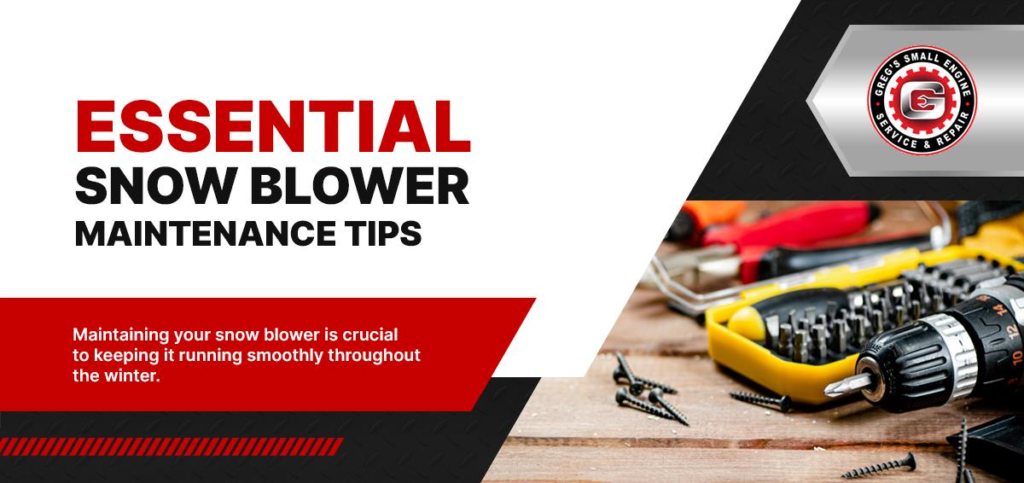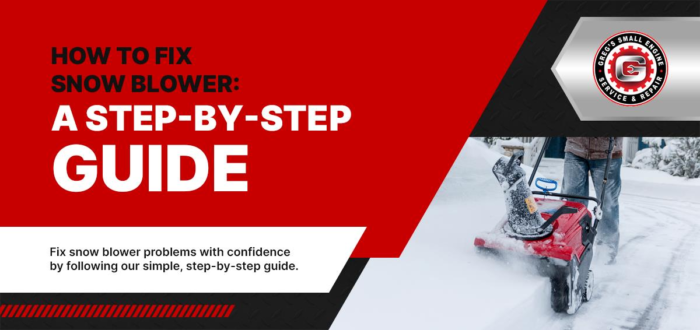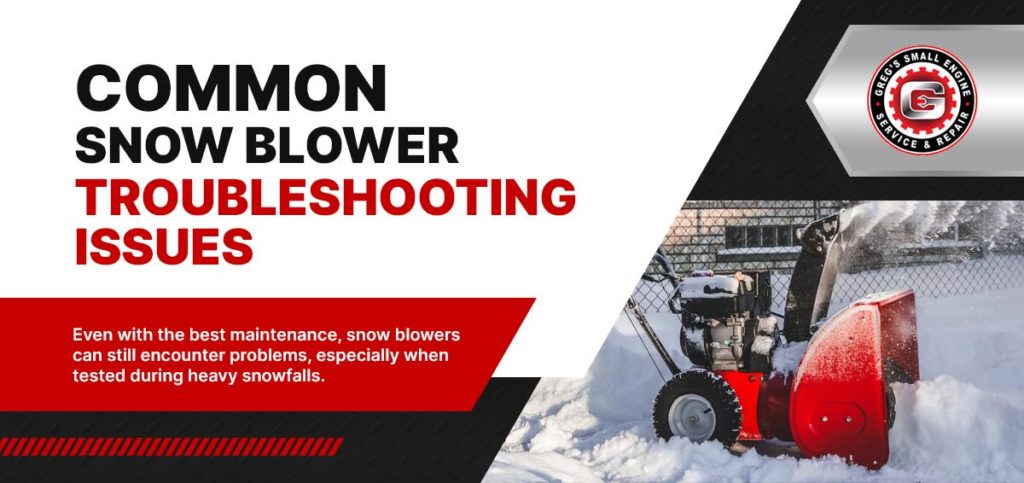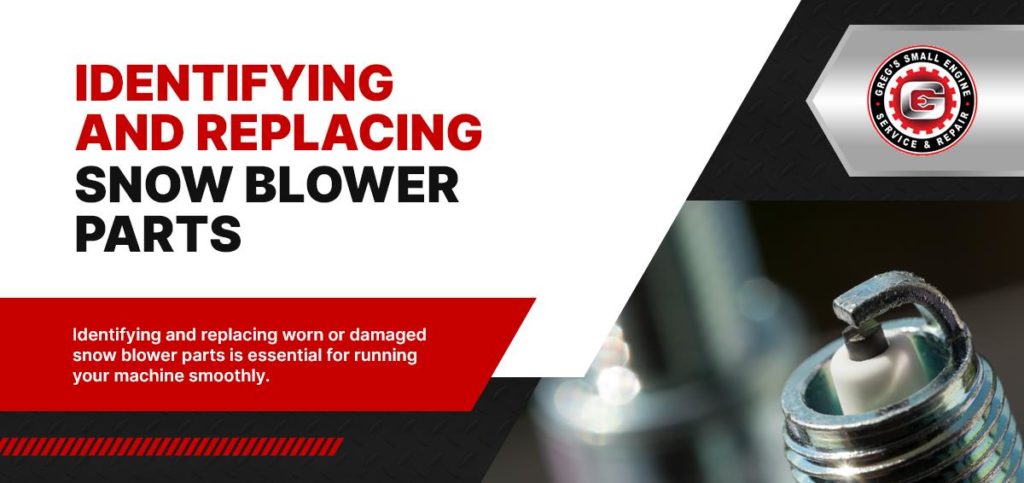Fix snow blower problems with confidence by following our simple, step-by-step guide. Whether you’re dealing with a stubborn engine, clogged auger, or a malfunctioning chute, we’re here to help you get your snow blower back in shape.
That’s why we’ve put together this easy-to-follow guide designed to make snow blower repair as hassle-free as possible. With our expert tips and a little elbow grease, your snow blower will run smoothly in no time.
Essential Snow Blower Maintenance Tips 
Maintaining your snow blower is crucial to keeping it running smoothly throughout the winter. Regular snow blower maintenance ensures your machine performs efficiently and extends its lifespan, saving you from repairs and headaches.
1. Check and Change the Oil
Oil is the lifeblood of your snow blower’s engine. Regularly checking and replacing the oil helps to keep the engine running and prevents damage from dirty or old oil. You should change the oil at least once a season or after every 25 hours. To check the oil:
- Turn off the engine and let it cool.
- Remove the dipstick, wipe it clean, and insert it back into the oil reservoir.
- Pull it out again to check the oil level. If it’s low, top it up with the oil recommended by your snow blower’s manufacturer.
- If the oil looks dirty or dark, it’s time for a change. Drain and refill with new oil.
2. Inspect Air Filters and Spark Plugs
Air filters are vital in keeping dirt and debris from contaminating the engine, which could lead to performance issues. Regularly checking and cleaning them is essential for optimal performance. If the filter is too dirty or damaged, it’s time for a replacement. Here’s how to check:
- Remove the air filter cover.
- Inspect the filter for dirt or damage. Clean it with compressed air or replace it if necessary.
- For optimal engine performance, replace the air filter every season or if it appears worn.
Spark plugs are another crucial part of your snow blower’s engine. They help ignite the fuel to start the engine, so keeping them in good condition is important. Inspect the spark plug for wear and buildup:
- Remove the spark with a spark plug wrench.
- Check for any carbon buildup or damage. Clean the plug with a brush if needed.
- If the spark plug is cracked or heavily worn, replace it with a new one to ensure easy starting.
3. Maintain the Fuel System
Proper fuel maintenance is essential for keeping your snow blower running smoothly throughout the season. Here are a few tips to ensure your fuel system stays in good shape:
- Use fresh fuel: Always use fresh gasoline in your snow blower. Gasoline degrades over time and can cause your snow blower to malfunction or not start.
- Add fuel stabilizer: If you’re storing your snow blower for an extended period, add a fuel stabilizer to prevent the fuel from breaking down and gumming up the fuel system.
- Check the fuel filter: Over time, the fuel filter can become clogged with debris. Inspect it regularly and replace it if necessary to keep the fuel system flowing smoothly.
4. Lubricate Moving Parts
Snow blowers have many moving parts that need regular lubrication to prevent wear and tear. These parts include the auger, drive system, and chute control. Lubricating these parts ensures they move freely and efficiently. Check your owner’s manual for specific lubrication recommendations, but generally:
- Apply grease to the auger shafts and other moving components.
- Lubricate the drive system to ensure smooth operation.
Following these essential snow blower maintenance tips ensures your machine stays in top condition all season.
Common Snow Blower Troubleshooting Issues
Even with the best maintenance, snow blowers can still encounter problems, especially when tested during heavy snowfalls. Understanding the most common snow blower troubleshooting issues and how to fix them can save you time and frustration.
1. Engine Won’t Start
A snow blower that won’t start is one of the most frustrating issues, but fortunately, it’s often easy to fix. There are a few common causes behind this problem:
- Fuel issues: Ensure your snow blower has fresh fuel. Gasoline goes stale if left unused for long periods. If you’ve used old fuel, drain the tank and replace it with fresh fuel.
- Spark plug problems: A dirty or worn spark plug can prevent the engine from starting. Remove the spark plug and check for buildup. Clean it with a wire brush or change it if needed.
- Choke position: Double-check that the choke is in the correct position. If the choke is stuck or improperly set, the engine may not start.
- Fuel shutoff valve: If your snow blower has a fuel shutoff valve, ensure it’s in the “on” position.
If you’ve checked all these factors and the engine still won’t start, it may be time to consult a professional for further diagnosis.
2. Snow Blower Won’t Throw Snow
One of the key functions of a snow blower is its ability to throw snow. If your snow blower isn’t doing this effectively, there are a few things to check:
- Clogged auger or chute: Snow can build up inside the auger or chute, causing a blockage. Turn off the snow blower, then clear out any snow or debris clogging the system.
- Broken or worn auger belt: The auger belt turns the auger blades. If it is loose, broken, or worn, it won’t be able to move the snow effectively. Inspect the belt and replace it if needed.
- Frozen or damaged impeller: It can’t correctly expel snow if frozen or damaged. Ensure the impeller is debris-free, and check if it’s working correctly.
By checking these components and ensuring they’re clear and functioning, you can return your snow blower to throwing snow as it should.
3. Uneven Snow Clearing
If your snow blower is only clearing snow in some areas and leaving snow behind, the problem may lie with the drive or auger system:
- Auger imbalance: An unbalanced or damaged auger can cause uneven snow clearing. Inspect the auger blades for damage or wear. Replace any damaged blades to restore smooth operation.
- Drive system issues: If the wheels or tracks aren’t moving evenly, it can lead to uneven snow clearing. Check the tire pressure or inspect the tracks for damage. Lubricating the drive system might also help resolve this issue.
- Improper height adjustment: Check that the snow blower’s skids are properly adjusted. If they’re too high, the snow blower won’t be able to pick up snow effectively, especially on uneven surfaces.
4. Snow Blower is Stalling
If your snow blower stalls during operation, it may be due to fuel or air system problems:
- Dirty air filter: A clogged filter restricts airflow to the engine, causing it to stall. Clean or replace the air filter as needed to ensure proper engine performance.
- Fuel delivery issues: If your fuel lines or carburetor are clogged, it can cause the engine to stall. Clean the carburetor and inspect the fuel lines for blockages.
- Low oil levels: Low oil levels can make the engine stall. Check the oil levels and top them off if necessary.
Addressing these potential issues can prevent your snow blower from stalling mid-operation.
5. Loss of Power
If your snow blower is losing power, it may be working harder than it should due to the following:
- Clogged intake or exhaust: Make sure the intake and exhaust are free from blockages. Snow, dirt, and debris can sometimes get lodged in these areas, restricting airflow and causing a loss of power.
- Worn belts or pulleys: Check the belts and pulleys for wear. A worn or slipping belt can reduce the power transferred from the engine to the auger and drive system.
Maintaining clean air and exhaust systems and inspecting the belts will help restore your snow blower’s power so it can operate at full capacity.
Identifying and Replacing Snow Blower Parts
Identifying and replacing worn or damaged snow blower parts is essential for running your machine smoothly. Over time, specific components can wear out due to regular use, but with a little knowledge, you can replace them yourself, saving time and money.
1. Inspecting the Auger and Impeller
The auger and impeller are key components that help move snow into and expel the chute. If your snow blower is not throwing snow effectively or the engine seems to struggle, these parts may be worn or damaged. Here’s how to inspect and replace them:
- Visual Check: Look for cracks, bends, or signs of wear on the auger blades and impeller.
- Clear Obstructions: Sometimes snow or ice can build up, causing the auger and impeller to get stuck. Turn off the machine and clear out any debris.
- Replacement: If the auger or impeller is damaged, replace them with parts that match your snow blower’s model. Ensure they’re securely mounted and rotate smoothly.
Replacing these parts can restore your snow blower’s efficiency and ensure it performs at its best during heavy snowfalls.
2. Replacing the Drive Belt
The drive belt takes power from the engine to the wheels, enabling your snow blower to move forward. Over time, the belt can wear out, stretch, or even snap. The drive belt could be the culprit if your snow blower has trouble moving or seems sluggish.
- Inspect the Belt: Inspect the belt for wear, such as cracks, fraying, or looseness.
- Test the Tension: If the belt feels loose, it may need to be tightened or replaced.
- Replacement: To replace the drive belt, disconnect the spark plug to ensure safety. Remove the housing and access the belt. If worn or damaged, replace it with a new one compatible with your snow blower’s model.
A properly functioning drive belt ensures smooth movement, making tackling any job easier for your snow blower.
3. Checking and Replacing the Spark Plug
The spark plug is a small but vital component of your snow blower’s engine. It ignites the fuel and air mixture, starting the engine. If the spark plug is dirty, worn, or damaged, the engine may have trouble starting or stall during operation.
- Inspection: Remove the plug and inspect it for carbon buildup, cracks, or other damage. If the electrode is worn down or the plug is corroded, it’s time to replace it.
- Cleaning or Replacing: Clean the spark plug with a wire brush if it is slightly dirty. However, if it’s damaged or heavily fouled, it’s best to replace it with a new one.
- Installation: Ensure the spark plug is installed tightly but not too tight to dodge damaging the threads.
Regularly inspecting and changing the spark plug will help your engine start easily and run efficiently.
4. Replacing the Carburetor
The carburetor mixes air and fuel to make the combustion needed to run the engine. Over time, the carburetor can get clogged with dirt, debris, or stale fuel, causing the engine to run poorly or not start.
- Symptoms of a Faulty Carburetor: If your snow blower has trouble starting, stalls frequently, or the engine runs erratically, the carburetor may need cleaning or replacement.
- Cleaning: Before replacing the carburetor, try cleaning it using carburetor cleaner. Remove the carburetor from the engine bay, disassemble it, and clean all components carefully.
- Replacement: If cleaning doesn’t work, you may need to replace the carburetor. Ensure the new carburetor is compatible with your model, and follow the manufacturer’s instructions for installation.
A properly functioning carburetor ensures smooth engine operation, especially in colder temperatures.
Conclusion
With these helpful tips, you’re well on your way to keeping your snow blower in top condition all winter! Regular maintenance, quick troubleshooting, and knowing when to replace key parts can make all the difference in ensuring your snow blower is ready for any snowstorm that comes your way. By staying proactive with these fixes, you’ll avoid common issues, extend the life of your equipment, and enjoy a smooth, hassle-free winter season.
If you need any help with repairs or want a professional touch to get your machine in prime condition, don’t hesitate to reach out. We’re just a phone call away! Need help? Contact us today at 775-762-3406 or visit our contact page!



